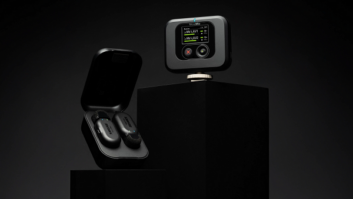San Diego – Chipset maker Magis Networks expects a handful of electronics suppliers to offer its wireless AV-networking solution in time for the holidays, enabling consumers to distribute standard-definition (SD) digital video streams from DVDs, PVRs, and PCs to TVs anywhere in a house.
The first products will also transmit music wirelessly from centrally located CD megachangers and hard-drive music servers to audio systems in other rooms.
‘At least two and possibly four customers will have products in time for Christmas,’ said marketing director Thomas Kovanic. ‘Another three or four will have something in time for spring.’ ViewSonic will be among the companies offering a product either this year or next spring, he said.
Products available later this year or the spring will also include two wall-hanging flat-panel display monitors that will incorporate a high-definition (HD) version of its Air5 technology, eliminating cables between the displays and an outboard HD set-top box.
Magis’s Air5 delivers 40Mbps available throughput in a home, potentially allowing for multiple simultaneous streams of SD video, or a mix of SD streams and one HD stream. The technology combines the 54Mbps, 5GHz-band IEEE-802.11a RF specifications with proprietary QoS technology that dynamically allocates bandwidth based upon the priority of the data type. The proprietary enhancements are designed to avoid the interference and dropout problems of wireless-data-networking technologies that require latency-inducing buffering of up to nine seconds to handle real-time video transmission, the company said. Air5, in contrast, reduces latency to 5 milliseconds.
Magis also adds Triple-DES encryption algorithm and its own authentication technology.
Simultaneous streaming of multiple sources won’t appear in the initial round of products, most of which will take shape as a pair of add-on digital media adapters (DMAs). Because the initial DMAs will be designed as ‘point-to-point’ links, the systems will be limited to one videostream or one music stream at a time, Kovanic said.
The first DMAs, many of which will be based on a Magis reference design, are expected to retail for around $200 to $250/pair.
Consumers will plug a DMA transmitter into a centrally located audio or video source. A companion receiver will plug into a TV or stereo system in a remote room. From the remote room, consumers will use any universal IR remote to control the centrally located source. IR commands sent to the DMA receiver’s IR eye will be converted to RF and relayed to the transmitter, which will convert the control signals back to IR and send them to the source unit via IR blaster.
Besides using DMAs with DVD players and PVRs, consumers will also be able to wirelessly connect a PC to a TV to remotely view downloaded movies or view TV programs recorded by a PC’s PVR function, Kovanic said.
Each DMA transmitter will feature three analog-video inputs and three audio inputs. The video inputs are composite, S, and component. The audio inputs are analog left-right stereo, SPDIF coaxial, and SPDIF optical. As a result, consumers could connect up to three video sources simultaneously to a transmitter, or three music sources, or a mix of video and music sources. Users would be able to toggle among the sources from buttons on the receiver’s front panel.
Magis’s development of a reference DMA design marked a change from earlier plans that focused only on embedded applications, said Kovanic, citing customer demand. In another change requested by customers, Magis developed an Air5 chipset only for SD applications, having previously planned only a chipset incorporating HD and SD capabilities. ‘A number of customers wanted only SD, and it gets the chip cost down,’ he explained. The SD chipset is part of the company’s DMA reference design
Volume production of SD and HD/SD chipsets begins in October, about six to nine months behind schedule because of initial ‘aggressive scheduling,’ Kovanic said.
The first products aren’t guaranteed to be interoperable among brands, but Magis has formed a special interest group (SIG) with multiple suppliers to ensure interoperability in future products. ‘We provide the basic toolkit [including Triple DES encryption algorithm] that lets suppliers encrypt the link and exchange authentication keys,’ but each supplier’s implementation can be incompatible, he explained. ‘The SIG could standardize this within a year, and products could come out quickly after because it’s just a software change,’ he continued.
SIG members include BenQ, InFocus, JVC, Motorola, Samsung, Sanyo, and ViewSonic. Magis’s investors include AOL Time Warner, Motorola, Panasonic, Sanyo, ViewSonic, Hitachi, and various investment funds.
Magis’s reference DMA design allocates 12Mbps bandwidth to an SD stream, more than needed, to ensure that Air 5 ‘doesn’t get in the way’ of delivering a DVD’s full resolution, Kovanic said. With 12Mbps dedicated per stream, future SD DMAs could stream up to three SD programs simultaneously as *long as they included three MPEG2 encoder/decoder pairs.
PVRs and digital cable boxes with embedded Air5 technology would be capable of delivering even more simultaneous streams, he noted. In those cases, the content would be passed through in their native digital format, allowing for multiple 3-6Mbps (peak) digital-cable streams and multiple 5Mbps (peak) DVD streams into the available 40Mbps throughout, he said.
U.S.-market HD streams require about 19.2 Mbps peak bandwidth.













